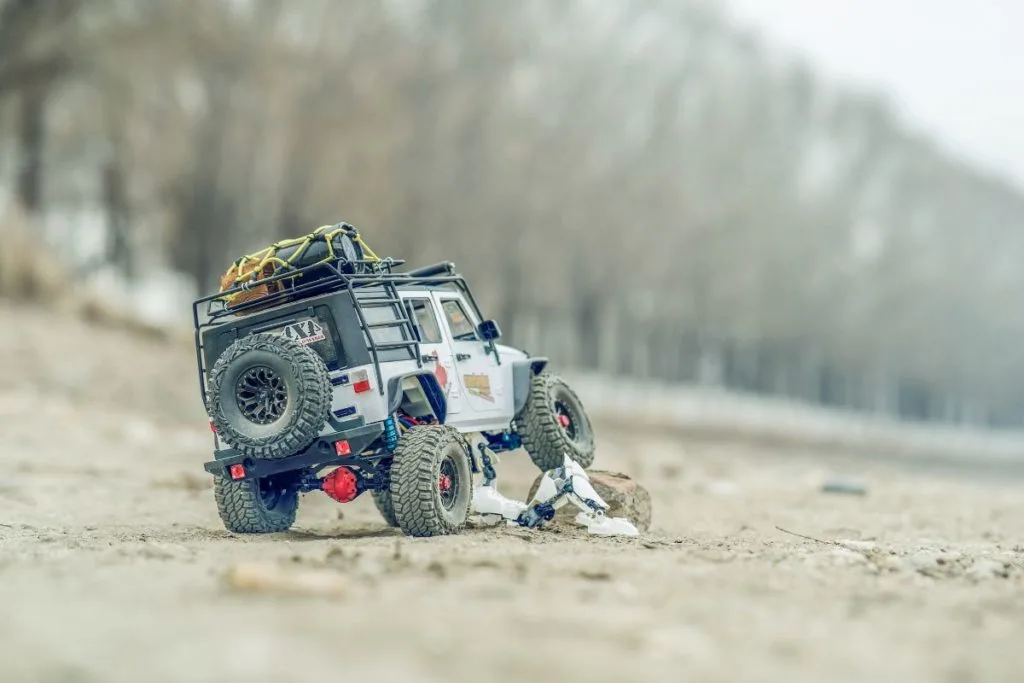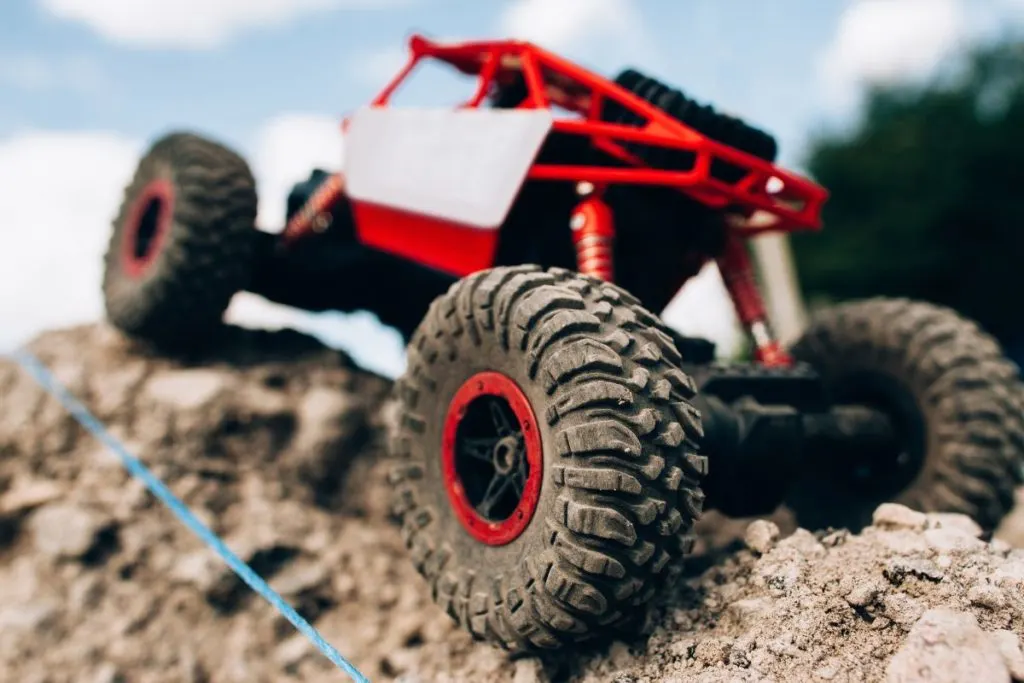*This post may contain affiliate links. As an Amazon Associate we earn from qualifying purchases.
Hey there RC enthusiasts! Tired of driving your boring old remote control cars on flat surfaces? Want to take your hobby to the next level?
Look no further than the exciting world of RC rock crawling!
In this ultimate guide, I’ll take you through the ins and outs of these amazing RC vehicles. From choosing the right crawler to dominating the competition scene, I’ve got you covered. Let’s get started, shall we?
RC rock crawlers are the off-road kings of the RC world. These bad boys can handle the toughest terrain and make it look like a walk in the park.
Trust me, there’s nothing quite like taking your crawler to the top of a steep incline and basking in the glory of your remote control victory. Plus, they’re just plain cool to look at.
But, before you go out and buy one of these bad boys, let’s go over the different types of RC rock crawlers.
First, we’ve got the ready-to-run (RTR) crawlers. These are the most beginner-friendly option and come fully assembled. Just charge the batteries and you’re good to go.
Then, we’ve got the kit crawlers, which require some assembly but offer more customization options.
Finally, we’ve got the custom crawlers, which are built from scratch by the owner. Getting (and building) a custom RC rock crawler can take some time and money but the end result is a one-of-a-kind machine.

Getting Started
So you’ve decided to take the plunge and buy an RC rock crawler. Congratulations! You’re in for a wild ride. Now, it’s time to choose the right crawler for you.
Do you want a kit or RTR? What kind of terrain will you be using it on? What’s your budget? Don’t worry, I’ll guide you through it.
Once you have your crawler, it’s important to have the right equipment and tools. This includes extra batteries, charger, and a screwdriver set.
Trust me, you don’t want to be stranded on the side of a mountain with a dead battery.
Regular maintenance is key to keeping your crawler in tip-top shape. This includes cleaning, tightening loose screws, and lubricating moving parts.
Remember, a well-maintained crawler is a happy crawler.

Driving Techniques
So you’ve got your crawler and you’re ready to hit the trails. Hold on there, chief. Before you go off-roading, it’s important to know the basics of driving a crawler.
This includes throttle control, steering, and weight distribution.
Climbing steep inclines can be tricky. But with a little bit of throttle control and weight distribution, you’ll be king of the mountain in no time.
Descending steep inclines can be just as challenging. Remember to go slow and keep the weight of your crawler towards the front.
Traversing difficult terrain requires a steady hand and a good understanding of your crawler’s capabilities. It’s important to know the limits of your crawler and when to back off.
It’s better to take a few extra minutes to navigate a tricky section than to break your crawler and have to walk of shame back to the car.

Modifying and Upgrading Your RC Rock Crawler
So you’ve mastered the basics and you’re ready to take your crawler to the next level. That’s where modifications and upgrades come in.
From new tires and shocks to a more powerful battery, the possibilities are endless.
But before you go modifying your crawler, it’s important to understand why you want to make these changes. Are you looking for more speed? More power? Or better performance on a specific terrain?
Knowing your goals will help you choose the right modifications and upgrades.
Upgrades like better tires, shocks and even motors can greatly improve the performance of your crawler.
But remember, with great power comes great responsibility. It’s important to choose the right parts and accessories that will work with your crawler and not damage it.
Racing and Competition
So you think you’re ready to take your crawler to the next level and show off your skills? Then it’s time to hit the race track (or race rocks in this case)
RC rock crawling competitions can be a lot of fun and a great way to meet other enthusiasts.
But before you sign up for your first competition, it’s important to prepare your crawler and yourself. This includes regularly maintaining your crawler and practicing your driving techniques on various terrain.
It’s also important to familiarize yourself with the rules and regulations of the competition you’re participating in.
When it comes to racing and competing, there are no shortcuts to victory. But with a well-prepared crawler and some smart driving, you’ll be sure to turn some heads and come out on top.
Safety Precautions
Yes, RC rock crawling is a lot of fun, but safety should always come first. It’s important to always wear protective gear, such as goggles or glasses, to protect yourself.
I know that might seem like overkill but if you are close to your crawler and it spins some rocks loose you will be thankful you have an a pair of goggles or glasses.
When driving your crawler, it’s important to be aware of your surroundings and always be aware of potential hazards. This includes other people, animals, and obstacles in your path.
In case of an emergency, it’s important to have a plan in place and know what to do. This includes knowing how to turn off your crawler quickly and having a first aid kit on hand if it happens to fall on top of someone (especially if your rock crawler is custom-built and pretty heavy).
Popular Brands and Models
There are countless brands and models of RC rock crawlers on the market. Each has its own unique features and capabilities. Some popular brands include Axial, Traxxas, and RC4WD.
Some popular models include the Axial SCX10 II, the Traxxas TRX-4, and the RC4WD Gelande II. Each of these models has its own pros and cons, and it’s important to do your research and choose the one that best suits your needs and preferences.
For beginners, I recommend the RTR models, they’re easy to set up and use. For experienced users looking for more customization options, a kit crawler might be a better fit.
Building Your Own RC Rock Crawler
If you’re the DIY type and want something truly unique, then building your own RC rock crawler might be the way to go. Building your own crawler can be a fun and rewarding experience, and it allows you to create a machine that is truly your own.
Building a crawler from scratch requires some knowledge and experience, but with the right tools and guidance, it’s definitely achievable.
From sourcing parts to assembling and testing, it’s a process that requires patience and dedication.
Some tips and tricks to successful building include, sourcing high-quality parts, making a plan and following it, taking your time, and test run before finalizing the build.
Accessorizing Your RC Rock Crawler
Once you’ve got your crawler up and running, it’s time to start accessorizing! From LED lights to winches, there are countless accessories available to customize your crawler and make it truly unique.
When it comes to accessorizing, it’s important to choose the right accessories for your specific use case. For example, if you’re planning on using your crawler for racing, you might want to focus on performance upgrades rather than lights and sound systems.
However, if you’re looking for a more scale-like experience, body shells and other aesthetic accessories might be the way to go.
Final Thoughts
In conclusion, RC rock crawling is an exciting and rewarding hobby, but it’s important to understand the ins and outs of these bad boys before you dive in. From choosing the right crawler to dominating the competition scene, I’ve covered it all in this ultimate guide.
Remember, safety first, have fun, and happy crawling!
How fast can RC rock crawlers go?
Speed varies depending on the model and conditions, but most RC rock crawlers can reach speeds of around 10-15 miles per hour.
How long do RC rock crawler batteries las
It depends on the battery type, but most last for around 30-60 minutes.
How difficult is it to control an RC rock crawler?
With practice and experience, most people can learn to control an RC rock crawler effectively without much difficulty. Some models are more challenging to control than others, and driving on difficult terrain can be challenging even for experts.
